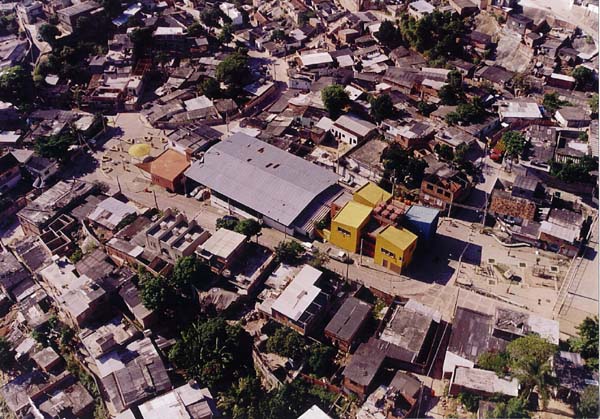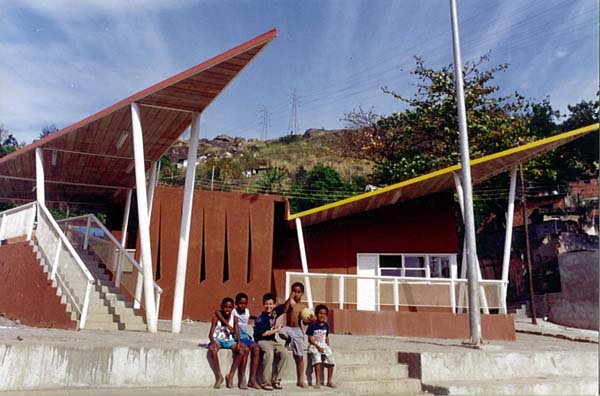Jorge Mario Jauregui. A project for the favelas of Rio de Janeiro
|
Today it is possible to identify in Latin America, four modes of urban intervention that implies a specific cultural position. A defensive urbanism is understood as the actions of historical protection reported to architecture, urbanism or natural inheritance (in Rio for example, the established “cultural corridor” program, in the historical sector of the city); an urbanism of re-qualification, that put the accent on the physical form, destined to recompose the “urbanity” through actions of renovation, (in Rio for example the Rio-Cidade program, that intervene in the principal urban axes of the neighborhoods in the formal city); a strategic urbanism where the actions are limited to a few points or areas of intervention, trying to interpret the forces and the logics that modifies the territory, looking to “canalize” it (in Buenos Aires for example, the Puerto Madero project), and an urbanism of physical and social articulation, that emphasizes the multiplicator aspects of urban actions, trying to stitch together the territory of the city to combat social-urbanistic segregation, which is the case of the Favela-Bairro program in Rio. This conception looks to confront the “deficit of the city”, the non-city in the “large pockets” of exclusion, configuring public space and introducing services, installations for generation of work and income, sport and cultural equipments, connecting the formal and informal texture of the city. That signifies to establish relations between physical and social aspects in two perspectives: one strategic (urban scheme), and another tactical (intervention plan). These paradigms of action present questions of sense, validity and congruence, that involves differentiated approaches of relationships between ethic, aesthetic and politic. In a general way, we can say that planning is like trying to prepare the city to create possibilities “to make rain”, capturing the “cloud of the globalization”, that means, try to attract resources and investments. At the same time, the projects of urban scale look for the introduction of values through interventions and modifications in the infrastructure, in the composition of an aesthetically elaborated urban landscape, and by the introduction of quality equipment in the public space. These projects aim to produce what we might call “urban excitement” by pointing out the evidence of the qualities, the potentialities and the level of integration wished to the urban space. From a global viewpoint, we can see the program of shantytowns urbanization denominated “Favela-Bairro” as the picture of projects which strategic sense consists in breaking the barrier of the “divided city” between “asphalt” and “hill”(morro), formal and informal, included and excluded, through improving and giving it a form, and qualified spaces of acquaintanceship. To think in an urbanistic way about the favelas integration, implies conceiving the task as part of the Urban Project that involves a reconquest strategy of the city, seeking its re-articulation. This idea of Urban Project involves the formulation of a strategy space (directed through projects of urban structuration) and of a social strategy (based on the mobilization of the inhabitants searching for their participation in the programs definition and in the accompaniment of the process as a whole), that means, to think in the creation of an favorable “atmosphere” to social integration. The area of the favelas in Rio includes the third part of the city population, approximately 1,500,000 people. Special projects, like these presented here, conjugate all the entire range of problems that characterize a very complex situation as those of a mega city. These projects place Rio in the vanguard of the initiatives, both in the national level and in the rest of the Continent. It is about the creation of “centrality poles” capable to extend the urban effect to the adjoining areas, connecting and integrating the favelas to the district neighborhoods. Thus, places constituted without planning will acquire by the interventions, an urban responsibility. In this sense, we can talk about the “magma” of the favelas, that are locals where the urbanity is “in progress”, in process of constituting a new entity, starting from a crossroad between the conditions of every specific place, the established uses and the transformation project. The project of the favela’s urbanization involves the internal restructuration of each intervention area as well as the reformulation of its relationships with its surroundings. In an integrated way the following aspects are the main ones: infrastructure, the incorporation of services and equipment of cultural and sporting character, the creation of conditions for generation of income and work, and also, the aspects of property regularization and the reported to the normative subjects as expansion limitation, building norms, and use and occupation of the ground. To urbanize favelas implies thinking about the urbanism and the architecture as a function of social service, capable to allow access to the citizenship making possible that the improvement of spaces used in daily life, should act positively in the citizen’s self-esteem. In this sense, it is important the creation of a connective public space capable to reinforce the existent centers (or the germs of it) and to propose new coexistence centers with symbolic value as bases for variety activities, acquaintanceship and social exchange that several communities presents, looking to increase its scale. One previous condition of this project is to know how to ask “the right questions” about the position and context conditions about the intervention area. It is in terms of history, economy, technical situation and the physical configuration process as well as it is among the social, cultural and productive relationships. The places must be “well asked”. As experience product of the interventions in more than 15 favelas in Rio de Janeiro during the last 7 years, with population from 850 families (Fernão Cardin) to 12.000 families (60.000 inhabitants in Rio das Pedras-work in progress). The formulation of the “Partido Urbanistico” (Urban Scheme concept) constitutes a nodal structure that permit the establishment of a coherence picture about the rehabilitation. Different from earlier urbanism, in which results were a sum of participation by different specialists, nowadays the work is done with an integrated vision of the problems, and leaded from the urban project. Every favela is a piece of a great complexity and therefore a specific methodology was developed during these years, representing a simultaneous approach about different questions to be solved, by strategical focus on every aspect, every component of the problem, without losing the overall picture. The objective is to introduce “seeds of urbanism” in the heart of every community, to be able to “contaminate” it in a positive way, both physically and socially. This start with the identification of the deficits and the potentials, and with the characterization of the form of functioning of each community structure, in a permanent dialogue with many interlocutors and specially, with the inhabitants who approve every project in a public assembly in the favela. The Urban Scheme formulation of the mentioned concept, represents the principal key to all the projectual process and implies a composition of a specific place, defined by a basic articulation of a vectorial trace, through a sequence of dynamic and static points, which extract its logic through their own local conditions. It includes the conflicts and the contradictions which already exists, but interpreting them in a new transformed and opened way. In this sense, the image function, the specific design, has maximal relevance to allow the constitution of an identity focus, enabling the galvanization of the collective imagination, singularized in every intervention. Far away from standard architecture, the key is to look always for the identification elements from an angle of differentiation. In this sense, creativity and the elaboration of aesthetics are together, because aesthetic is the discipline that gives sense to things, not just reporting to the formal aspect. One important social function of urbanism and architecture in the favelas, is allowing the right to access the city for the most underprivileged people. Another important social function is to improve the access, the environmental conditions and the incorporation of equipments and services of communal interest, offering a new condition of urbanity to the inhabitants. It becomes an integrated part, recognized by the formal city, and from this moment, incorporated into an evolutionary process as in any normal neighborhood. A component part of projects, is the favela Fernão Cardin , the whole area being located at the edge of the Faria river. This renovated area (a no-place before the intervention) was used to link the city to the favela, that means, to function as an integration place of the favela with neighborhood, creating an urbanistic area including facilities for sport, communal services, commercial locals and relocation unites. The project tries to diffuse the line between the formal city and the favela, creating an urban “continuum” where the broken city, dissolves. During a visit to the place a journalist asked: “Where is the favela”? The Fernão Cardin case represents an example of the creation of a linear centrality punctuated by the principals urban-architectonical events projected: the relocation building, the public square constituting the place of integration “favela-bairro”, the center for the social and urban orientation, the soccer field including facilities, the day-nursery, etc. In case of Vidigal, a single major road leads through the community from the top to the bottom, like a back spine, serving as the distributer of all “events”, being nailed to the spine, every “vertebral” is a uniquely defined point with an especific identity. The Vila Olympica and it’s surroundings, the gymnasium and it’s connecting areas, the center of treatment of “Largo do Santinho”, the remodeling of the “Teatro Nós do Morro”, the center of Comlurb and the main square of access are some of these principal points. This is a track which results in the belvedere where the point of arrival for the projected lift will be located in the future. In Fubá-Campinho’s favela, the urban scheme implies the definition of a strong integrative public space, characterized by a civic square, where different “atmospheres” are structured and amalgamated. The access square, the playground for children, a square for the elderly, a soccer field with standings, a day-nursery, the terminal for garbage control, the center of social and urban orientation and the relocation building, are reached by the new circulating ways, producing a “core” that re-defines and potentializes the previously existent building of “samba”, that remained. But, if the cities of America do not have time to become old, as Claude Lévi-Strauss said in “Tristes Trópicos”, this is not, by any way, necessarily a handicap, instead, it is necessary to know how to handle it, transforming the obstacles into fountains of creativity, forcing us to come up with a different form of composition, if so, we should utilize this concept even with a lot of restrictions. To conclude: in the case of the favelas urbanization, the fundamental is to elaborate strategic projects from the structural reading of the potentials and limits, founded in every single case, and from it, to find out the basic principles which will lead to every specific project. In this way, to urbanize favelas signify to face the chaos until it turns into an amalgam of form, space and facilities for social integration.
|

